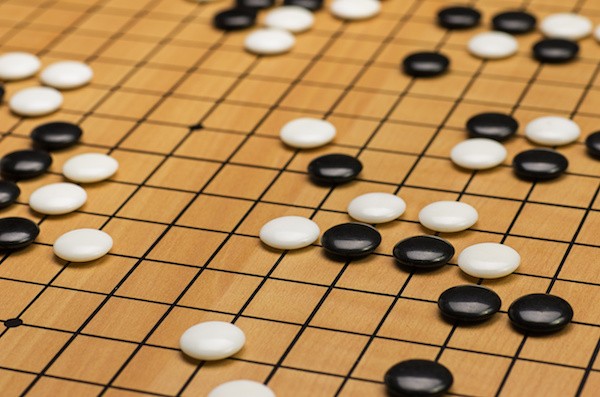Reminiscing about the good old days of media appears to be increasingly popular in the face of the Media Rebates controversy. The media ‘old timers’ fondly talk about media before programmatic, trading desks and even digital, when it was simpler and easier to manage.
But I believe media is like the ancient game of Go. You know the strategic game played on a board with black and white stones? If not the rules are defined here.
The thing about Go is that it is a simple game to learn to play, but you can spend a lifetime trying to master it. Media is the same in that people are inclined to believe that because they understand how media planning and buying works, then that is all they need to know.
Let me explain.
The simplicity of Go
Go is a game that is more than 3,000 years old and originated in China, but the name itself is Japanese. The game has wide appeal and is played by 5 to 90 year olds. From the British Go Association, the rules of Go are:
“A game of Go starts with an empty board. Each player has an effectively unlimited supply of pieces (called stones), one taking the black stones, the other taking white. The main object of the game is to use your stones to form territories by surrounding vacant areas of the board. It is also possible to capture your opponent’s stones by completely surrounding them.
Players take turns, placing one of their stones on a vacant point at each turn, with Black playing first. Note that stones are placed on the intersections of the lines rather than in the squares and once played stones are not moved. However they may be captured, in which case they are removed from the board, and kept by the capturing player as prisoners.
At the end of the game, the players count one point for each vacant point inside their own territory, and one point for every stone they have captured. The player with the larger total of territory plus prisoners is the winner”.
The simplicity of media
Media planning and buying is superficially also relatively simple in that it is about defining an audience, selecting media environments that deliver the desired audience to increase awareness and engagement and ultimately drive a change in attitude and behaviour.
But proof that advertisers find the rules of media relatively simple is the fact that the time given to it is small compared to the time given to other aspects of advertising such as creative.
At a time when creative agencies are often trying to bundle media back into their offering as ‘full service’ agencies, I am reminded of the times when during campaign development, the time spent on creative strategy and concept would be the first 50 minutes, with media covered in the last ten minutes.
Consider that for advertisers, the vast majority of the advertising budget is spent on media compared to the production of the advertising then the time allocated is often counter to the level of investment.
The difference between media and creative is obvious. Media is often presented as data driven and informed by research and performance, especially in the digital media age.
While creative may be research and data informed, but allows for a significant level of instinctive (and possibly subjective) input in the development and execution. After all it is hard to argue with numbers such as Reach, Frequency, Cost Per Thousand (CMP), Gross Rating Points (GRP) and the like.
This puts the emphasis on the agency for developing the media strategy and recommendation, with the advertiser often at best offering thoughts on the selected media environments. It precludes a deeper dive into media beyond the superficial because it is a world of data and numbers and performance measures that many advertisers feel is best left to the media agency experts.
Mastering Go and Media
They say of Go that it has a few simple rules but provides unlimited possibilities. This is the attraction of Go as it is a game that is easy to learn to play, in fact even a five year old can learn the rules of Go – It is easier than Chess. But it can take a lifetime to master the strategic nuances of the game.
A few moments to learn, a lifetime to master
– Ancient proverb
Likewise media provides an infinite number of ways to solve a problem and therefore while it may be easy to understand at a functional level it can take a lifetime to master. But adding to the complexity is the fact that, while the rules of Go have remained the same for centuries or millennia, the media playing field, the rules and the playing pieces are constantly evolving and changing.
Since the mid-nineteenth century at the emergence of the advertising agency, media was almost exclusively print – newspapers, posters, magazines, catalogues and billboards. Then twentieth century technology bought forward radio, television, junk mail, telemarketing and email.
Transitioning into the twenty first century came digital including banner ads, mobile, pop-ups, social media, mobile apps and native advertising. The pace of media change is accelerating and becoming more complex and accountable.
This has meant that for the marketer, diving deeper into the world of media is less attractive with its complexity and jargon. Programmatic buying, trading desks, demand side and supply side platforms are all best left to the experts at the media agency, right?
After all isn’t it enough to have an understanding of the rules of media, the way the game is played?
But the game has changed dramatically and the rules are being reinvented by the media agency and the media owners.
Of course it may be too hard to master the changing world of media. An advertiser has so much more to do than spend time mastering media. But for any player, it is essential you keep up with the new rules of the game, otherwise you could end up losing.
TrinityP3’s Media Transparency, Performance and Value Assessment takes a holistic look at the operation of your media agency, assessing against best practice at every stage of the journey. It aims to give you the tools to improve the output of your media agency.
Why do you need this service? Click here to learn more




